

Your guide to reading the world. “I’d always thought that I was well-traveled,” says writer Ann Morgan (TED Talk: My year reading a book from every country in the world), but “actually, when I looked at my bookshelves, they told a very different story about me.”
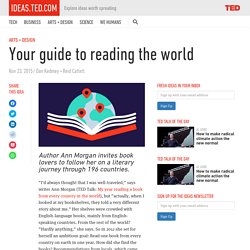
Her shelves were crowded with English-language books, mainly from English-speaking countries. From the rest of the world? “Hardly anything,” she says. So in 2012 she set for herself an ambitious goal: Read one book from every country on earth in one year. How did she find the books? Click on the red pins in the maps below to see all 196 recommended books. South America In her selected readings from South America, Morgan encountered a number of characters in the throes of mental illness. North America Much of Central American literature followed the patterns of South America. Europe “Some of the funniest books that I read during my quest came from Europe,” Morgan says. Africa. Collections. Click to visit the main New York Public Library Homepage The New York Public Library Digital Collections Browse Search only public domain materials Search Browse About Items Collections Divisions Digital Collections Using Images Using Data Collections Browsing all collections All Collections Print Collection portrait file 64,285 items Historical and Public Figures: A General Portrait File to the 1920s 60,752 items Cigarette cards 49,679 items Billy Rose Theatre Collection photograph file 49,110 items Robert N. 42,202 items Photographic views of New York City, 1870's-1970's, from the collections of the New York Public Library 34,749 items Mid-Manhattan Picture Collection.

Comp2. Bob Kentridge 1995.

Post-Structuralism Explained With Hipster Beards: Part 1. How To Talk To Babies About Post-Structuralism. Engaging Students in Learning History. The context. History of Psychology Learning Module. Lawrence J.
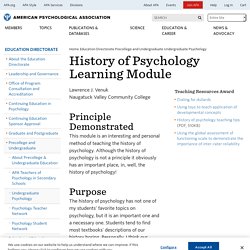
Venuk Naugatuck Valley Community College Principle Demonstrated This module is an interesting and personal method of teaching the history of psychology. How to Criticize with Kindness: Philosopher Daniel Dennett on the Four Steps to Arguing Intelligently. By Maria Popova “In disputes upon moral or scientific points,” Arthur Martine counseled in his magnificent 1866 guide to the art of conversation, “let your aim be to come at truth, not to conquer your opponent.
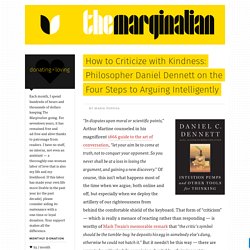
So you never shall be at a loss in losing the argument, and gaining a new discovery.” Of course, this isn’t what happens most of the time when we argue, both online and off, but especially when we deploy the artillery of our righteousness from behind the comfortable shield of the keyboard. Learning Malaysian History: A Lopsided Formula. A major problem with our school system has to be the way we teach history.
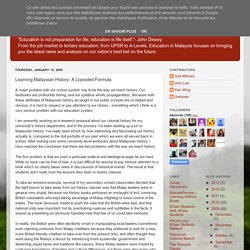
Our textbooks are profoundly boring, and our syllabus wholly propagandistic. Because both these attributes of Malaysian history as taught in our public schools are so blatant and obvious, it is hard to respect or pay attention to our history - something which I think is a very serious problem with our education system.I am presently working on a research proposal about our colonial history for my university's history department, and in the process I've been reading up a lot on Malaysian history. I've really been struck by how interesting and fascinating our history actually is, compared to the dull portraits of our past which we were all served back in school. After looking over some university-level textbooks about Malaysian history, I have reached the conclusion that there are two problems with the way we teach history.
The second problem is that we take far too much for granted. How to Memorize History Lessons: 13 Steps. Edit Article Two Methods:Using an OutlineSummarizing History can be one of the most difficult subjects for many students.
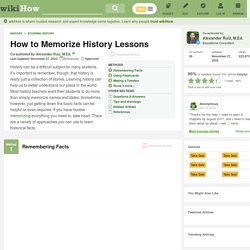
There are so many facts to learn: people, places, battles, laws, dates and more. If you have trouble memorizing everything, take heart. With the right approach, you can learn everything you need to know about history. How to Ace Your Finals Without Studying. I’ve never been that keen on studying before an exam.

I rarely study for more than a half hour, even for big final exams worth more than half my grade. When I do study, I usually just skim over the material and do a few practice questions. Chapter One: What is a learning history? In recent years, the idea of building a "learning organization" has gained currency in management circles.
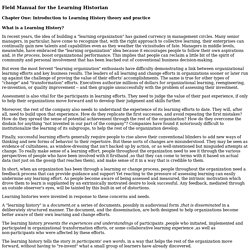
Many senior managers, in particular, have come to recognize that, with the right approach to collective learning, their enterprises can continually gain new talents and capabilities even as they weather the vicissitudes of fate. Managers in middle levels, meanwhile, have embraced the "learning organization" idea because it encourages people to follow their own aspirations and, in the process, boost organizational performance. This implies that people can reclaim a little bit of the spirit of community and personal involvement that has been leached out of conventional business decision-making. But even the most fervent "learning organization" enthusiasts have difficulty demonstrating a link between organizational learning efforts and key business results.
Assessment is also vital for the participants in learning efforts. The history includes reports of actions and results. 1. 2. 3. Studying and Holistic Learning. Like my article on speed reading, it seems that my article on holistic learning has brought a fair bit of confusion and controversy even for a large amount of coverage.
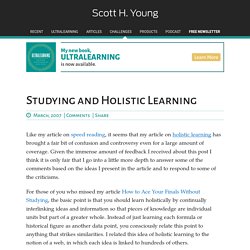
Given the immense amount of feedback I received about this post I think it is only fair that I go into a little more depth to answer some of the comments based on the ideas I present in the article and to respond to some of the criticisms.